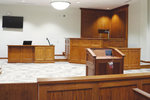

by Anna Dubas
UNL intern
A parking lot now sits where a tall metal fence once surrounded an outdoor jail yard at the Seward County Jail. Next to it, the complete and newly constructed Seward County Justice Center stands tall on the southwest corner of 8th and Main streets in Seward.
The new Seward County Justice Center combines the detention center, county and district court and sheriff’s department to create a one-stop place for justice. The center also includes probation, public defender, county attorney, E-911 and diversion offices.
Construction started in early 2016, with the goal to be completed by mid September - early October 2016. After a few unexpected setbacks, the first move-in date was Jan. 16, 2017. Seward County Sheriff Joseph Yocum said that the project has been a long time coming
There had been a slow, steady increase in the number of people housed daily in the
Seward County Jail over the past decade, Yocum said.
By 2004, the average daily population of prisoners was reaching capacity. The old facility was able to house 26 prisoners at one time, and the numbers were slowly increasing close to the maximum every day.
When there were more prisoners than could be held, Seward County had to pay to house prisoners at a jail in another county at $45-65 per day. If the prisoner needed to be held in the state prison, the cost could rise to more than $100 per day. For example, some county jails don’t have updated facilities or room to house women, so often they would be sent to the state prison.
After recognizing a pattern and figuring the numbers, Yocum said he brought the yearly budget data to the attention of the county commissioners. Yocum said he reported that in 2000, Seward County spent a total of $45,000 on all prisoner boarding – in house and outside.
Fast forward to 2012, Seward spent $145,000 just taking care of prisoners in its jail and $187,000 on housing prisoners in other outside jails.
At that time, the commissioners decided the cost was getting out of hand and something had to change. Yocum said the commissioners proposed a bond to finance construction of a new jail.
The people voted no on a $12.5 million bond in 2008 likely because people were uninformed, Commissioner Whitney Fleischman said. At the same time the bond for the center was proposed, another bond issue was proposed for the construction of the new middle school, which passed.
However, against the vote of the people, all five commissioners voted to build the new Justice Center under a provision in state law called the “nickel tax levy” in 2014.
The law allows the construction of a building without the vote of the people as long as the tax levy remains under five cents.
“It’s a legal thing to do as long as you don’t raise the levy over a nickel,” Commissioner Roger Glawatz said.
The construction began and the originally budgeted $12 million, three-story building began to rise.
Each level of the new Justice Center serves a different purpose. The lower level of center is the new county jail. There is now a segregation and classification area, so that when officers bring new prisoners into the jail they have holding areas specifically
designed for the crime they’re accused of committing. The old holding cell used to be a linear design instead of a pod design, which meant that someone arrested for assault could be in the same holding cell as someone caught committing identity theft.
In the new center, the prisoners will be separated by classification levels, keeping the
prisoners and the sheriff’s deputies working security safer. The center also allows women to be housed, drastically cutting the budget on outside prisoner housing.
The main level of the center contains probation offices, public defender’s offices and the new courtrooms.
Updated security is also a new feature the commissioners are proud of, as the courthouse had no security until the third floor.
Metal detectors and X-ray machines are at each entrance, and updated video technology allows attorneys to meet with their clients in the jail via video conference instead of face-toface. By implementing the new video technology, sheriff’s deputies do not have to risk moving prisoners from their cells to conference rooms.
The third floor of the Justice Center houses the sheriff’s office, county attorney’s office, diversion offices and E-911. The courts moved into the new offices the second week of August.